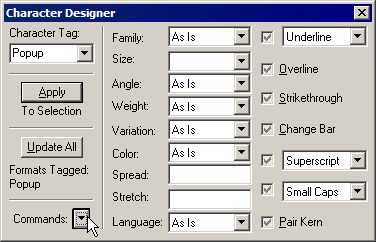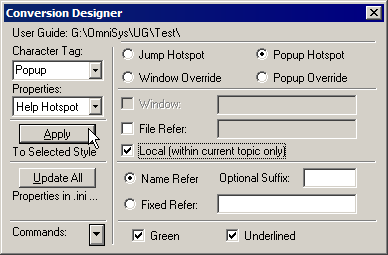34.1.1 Using character formats to identify Help elements
You can use character-format tagging to identify text you want to trigger help-specific actions. The character format need not have any effect on the text in FrameMaker; the format name is what Mif2Go goes by.
For example, to identify pop-up hotspots, you might create a FrameMaker character format called Popup, and apply it to each text item that should act as a pop-up hotspot in your help file. Suppose your document contains the following text:
As the fund-raising campaign progresses you will have an opportunity to visit Northcoast Redwoods and see for yourself the beauty of this forest.
Suppose you want “Northcoast Redwoods” to be a pop-up hotspot when you convert the document to Help:
1. Use the FrameMaker Character Designer Set Window to As Is command to define character
format Popup as shown in Figure 34
Figure 34

2. Apply character format Popup—which you have defined in Character Designer to be entirely “As Is”— to the phrase “Northcoast Redwoods”. The appearance of the text does not change in your FrameMaker document.
3. Add this setting to your project configuration file:
Or, create the same setting in Conversion Designer,
as shown in Figure 34
Figure 34

When Mif2Go converts your document, the text in the resulting
Help file looks something like Figure 34
Figure 34

Clicking Northcoast Redwoods pops up whatever text or graphics you define in your Help file to be a target for this pop-up.
§8.9.9 Using the same content for both normal topics and pop-ups
§8.9.11.5 Assigning properties to alternative jumps and pop-ups

